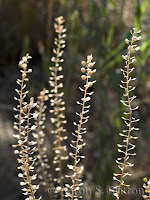
 Well, what with this abnormally warm winter we are having here in Athens, GA, I have had quite a few Stink Horns pop up in our herb garden.
Well, what with this abnormally warm winter we are having here in Athens, GA, I have had quite a few Stink Horns pop up in our herb garden.I don't know the specific type or varietal of this Stink Horn, but, from my observations, this stink horn starts off looking like a small white puff ball. After a few days go by they split open, like an egg cracking open, and then start to sprout some orange fleshy bits, usually in three or

 four prongs, sometimes knitted together at the top and sometimes separate. The closes way for me to describe the stink horn once it has fully grown is the inside of a red bell pepper with the sides cut away and only the rib of the bell pepper left over. The spores accumulate on the interior of the fungus, looking like a brown slimy substance, or a better description might be liquid feces.
four prongs, sometimes knitted together at the top and sometimes separate. The closes way for me to describe the stink horn once it has fully grown is the inside of a red bell pepper with the sides cut away and only the rib of the bell pepper left over. The spores accumulate on the interior of the fungus, looking like a brown slimy substance, or a better description might be liquid feces. If there were more bugs out and about, they would be covering these stink horns. I have seen flies, fruit flies, beetles, and slugs in the summer months swarming over and eating the Stink Horn. But, the winter has had a couple of cold days so the insects are just not around.
If there were more bugs out and about, they would be covering these stink horns. I have seen flies, fruit flies, beetles, and slugs in the summer months swarming over and eating the Stink Horn. But, the winter has had a couple of cold days so the insects are just not around.Here are a few photographs of the stink horns, called that because of the pungent smell they put off once fully grown.











































